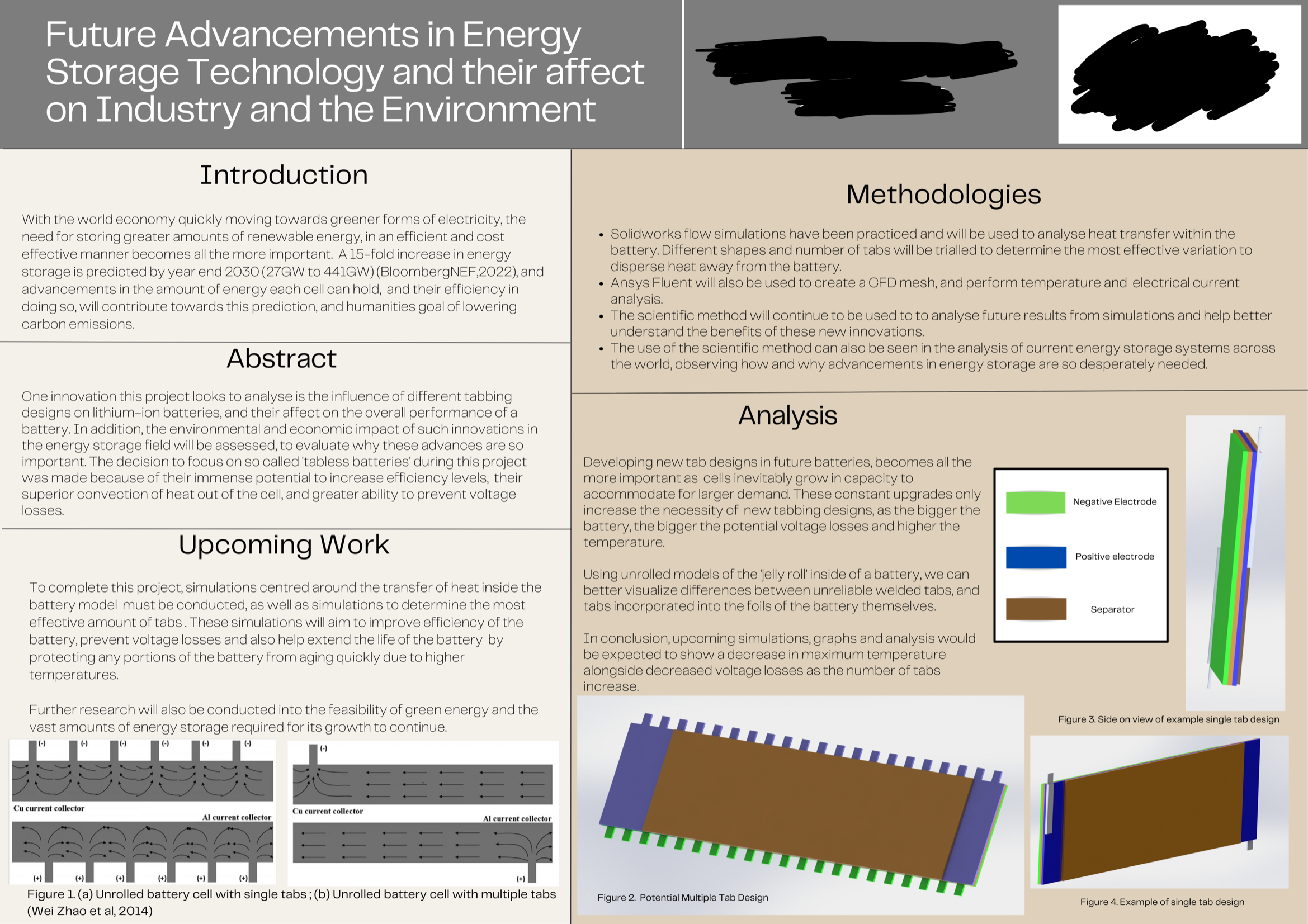Hi, can I please have some ideas of what sort of questions you would ask about this project? (The poster seen is meant as a review of what topic was picked and where the project is up to after a few weeks.)
Hi, can I please have some ideas of what sort of questions you would ask about this project? (The poster seen is meant as a review of what topic was picked and where the project is up to after a few weeks.)
Elements Of Electromagnetics
7th Edition
ISBN:9780190698614
Author:Sadiku, Matthew N. O.
Publisher:Sadiku, Matthew N. O.
ChapterMA: Math Assessment
Section: Chapter Questions
Problem 1.1MA
Related questions
Question
Hi, can I please have some ideas of what sort of questions you would ask about this project?
(The poster seen is meant as a review of what topic was picked and where the project is up to after a few weeks.)

Transcribed Image Text:in Energy
Future Advancements
Storage Technology and their affect
on Industry and the Environment
Introduction
With the world economy quickly moving towards greener forms of electricity, the
need for storing greater amounts of renewable energy, in an efficient and cost
effective manner becomes all the more important. A 15-fold increase in energy
storage is predicted by year end 2030 (27GW to 441GW) (BloombergNEF,2022), and
advancements in the amount of energy each cell can hold, and their efficiency in
doing so, will contribute towards this prediction, and humanities goal of lowering
carbon emissions.
Abstract
One innovation this project looks to analyse is the influence of different tabbing
designs on lithium-ion batteries, and their affect on the overall performance of a
battery. In addition, the environmental and economic impact of such innovations in
the energy storage field will be assessed, to evaluate why these advances are so
important. The decision to focus on so called 'tabless batteries' during this project
was made because of their immense potential to increase efficiency levels, their
superior convection of heat out of the cell, and greater ability to prevent voltage
losses.
Upcoming Work
To complete this project, simulations centred around the transfer of heat inside the
battery model must be conducted, as well as simulations to determine the most
effective amount of tabs. These simulations will aim to improve efficiency of the
battery, prevent voltage losses and also help extend the life of the battery by
protecting any portions of the battery from aging quickly due to higher
temperatures.
Further research will also be conducted into the feasibility of green energy and the
vast amounts of energy storage required for its growth to continue.
|(-)
(-)
|(-)
(-)
|(-)
(-)
(-)
Cu current collector
Al current collector
Cu current collector
Al current collector
(+)
(+)
(+)
(+)
Figure 1. (a) Unrolled battery cell with single tabs; (b) Unrolled battery cell with multiple tabs
(Wei Zhao et al, 2014)
(+)
Methodologies
• Solidworks flow simulations have been practiced and will be used to analyse heat transfer within the
battery. Different shapes and number of tabs will be trialled to determine the most effective variation to
disperse heat away from the battery.
Ansys Fluent will also be used to create a CFD mesh, and perform temperature and electrical current
analysis.
• The scientific method will continue to be used to to analyse future results from simulations and help better
understand the benefits of these new innovations.
• The use of the scientific method can also be seen in the analysis of current energy storage systems across
the world, observing how and why advancements in energy storage are so desperately needed.
Analysis
Developing new tab designs in future batteries, becomes all the
more important as cells inevitably grow in capacity to
accommodate for larger demand. These constant upgrades only
increase the necessity of new tabbing designs, as the bigger the
battery, the bigger the potential voltage losses and higher the
temperature.
Using unrolled models of the jelly roll' inside of a battery, we can
better visualize differences between unreliable welded tabs, and
tabs incorporated into the foils of the battery themselves.
In conclusion, upcoming simulations, graphs and analysis would
be expected to show a decrease in maximum temperature
alongside decreased voltage losses as the number of tabs
increase.
Figure 2. Potential Multiple Tab Design
Negative Electrode
Positive electrode
Separator
Figure 3. Side
view of example single tab design
Figure 4. Example of single tab design
Expert Solution
This question has been solved!
Explore an expertly crafted, step-by-step solution for a thorough understanding of key concepts.
Step by step
Solved in 2 steps

Knowledge Booster
Learn more about
Need a deep-dive on the concept behind this application? Look no further. Learn more about this topic, mechanical-engineering and related others by exploring similar questions and additional content below.Recommended textbooks for you

Elements Of Electromagnetics
Mechanical Engineering
ISBN:
9780190698614
Author:
Sadiku, Matthew N. O.
Publisher:
Oxford University Press

Mechanics of Materials (10th Edition)
Mechanical Engineering
ISBN:
9780134319650
Author:
Russell C. Hibbeler
Publisher:
PEARSON

Thermodynamics: An Engineering Approach
Mechanical Engineering
ISBN:
9781259822674
Author:
Yunus A. Cengel Dr., Michael A. Boles
Publisher:
McGraw-Hill Education

Elements Of Electromagnetics
Mechanical Engineering
ISBN:
9780190698614
Author:
Sadiku, Matthew N. O.
Publisher:
Oxford University Press

Mechanics of Materials (10th Edition)
Mechanical Engineering
ISBN:
9780134319650
Author:
Russell C. Hibbeler
Publisher:
PEARSON

Thermodynamics: An Engineering Approach
Mechanical Engineering
ISBN:
9781259822674
Author:
Yunus A. Cengel Dr., Michael A. Boles
Publisher:
McGraw-Hill Education

Control Systems Engineering
Mechanical Engineering
ISBN:
9781118170519
Author:
Norman S. Nise
Publisher:
WILEY

Mechanics of Materials (MindTap Course List)
Mechanical Engineering
ISBN:
9781337093347
Author:
Barry J. Goodno, James M. Gere
Publisher:
Cengage Learning

Engineering Mechanics: Statics
Mechanical Engineering
ISBN:
9781118807330
Author:
James L. Meriam, L. G. Kraige, J. N. Bolton
Publisher:
WILEY